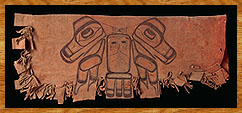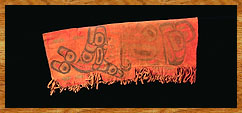(Page 2 of 2)
 |
Each dancing society had it own distinctive features. Some societies were the exclusive right of particular village chiefs and not widely distributed on Haida Gwaii. Swanton and Curtis interviewed many informants sufficiently long after the passing of the societies that they revealed some facts which otherwise would have been kept secret.
Swanton claims that the secret societies were merged with the shamanic beliefs of the Haida:
Just as a shaman was supposed to be inspired by some supernatural being who "spoke," or, as they generally preferred to translate it to me, "came through" him, so the U'lala spirit, the Dog-eating spirit, the Grisly-Bear spirit, and so on, "came through" the secret-society novice.
One of the main societies was the Ulala (or Wilala), similar to the Hamatsa (or Cannibal) among the Kwakiutl, which was danced only by men. A long pole with a crossbar projected through the roof from behind the dance curtain and had cedar bark streamers suspended from it. This pole was rotated to signal to those outside that the Ulala was about to emerge. According to Curtis, "Various masks were worn by Ulala, depending on the supposed source of his supernatural power."

 |
This deerskin bag, which held powdered red ochre for paint used in a variety of ceremonies, has seen much wear. The double-headed Thunderbird on the front is a rarity among the Haida, who usually portray it with a single head. It is very similar in form to a tattoo design and may have been used as such by the owner.
Collected from Skidegate between 1890 and 1904 by Charles F. Newcombe.
CMC VII-B-538 (S92-4235) |
| |
 |
The style of the painting on this deerskin bag (used to store red ochre for paint) is truly outstanding and was done by an unknown master artist of the middle of the last century. On the bag are two classic opposites: the Thunderbird, which is the supreme sky being, and the Killer Whale, which is one manifestation of the Chief of the Seas.
Collected at Skidegate between 1890 and 1904 by Charles F. Newcombe.
CMC VII-B-537 (S92-4233) |

Much of what shocked and repelled the early missionaries about the winter dances was the stagecraft, which they took very literally. Curtis describes some such enactments by the Ulala:
He made the gestures and facial expressions of the Hamatsa, and pretended to bite either forearm of several persons. Actually he did not bite at all. Those who were to be "bitten" had previously raised a blister on the forearm by burning cedar-bark over a round spot, so that after the "biting" they could exhibit a raw wound. Many of the oldest men have numerous such scars extending along the arm.
On appearing at the edge of the woods, Ulala mounted a mortuary hut and took out an image closely resembling a corpse. It was covered with the dark skins of scoters, and looked much like a dried, mouldy corpse. Inside the belly was a mass of cooked spruce-bast, or a long string of flour paste colored bluish so as to resemble intestines. Sometimes the initiate would tear the belly skin open and there on the beach devour the contents, but usually the "corpse" was taken from him and carried into the house, where he ate and passed portions among the other Ulala.
|